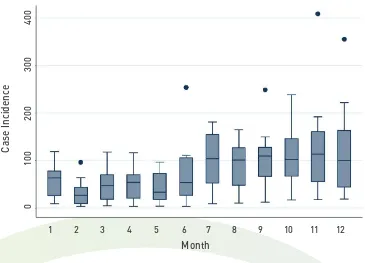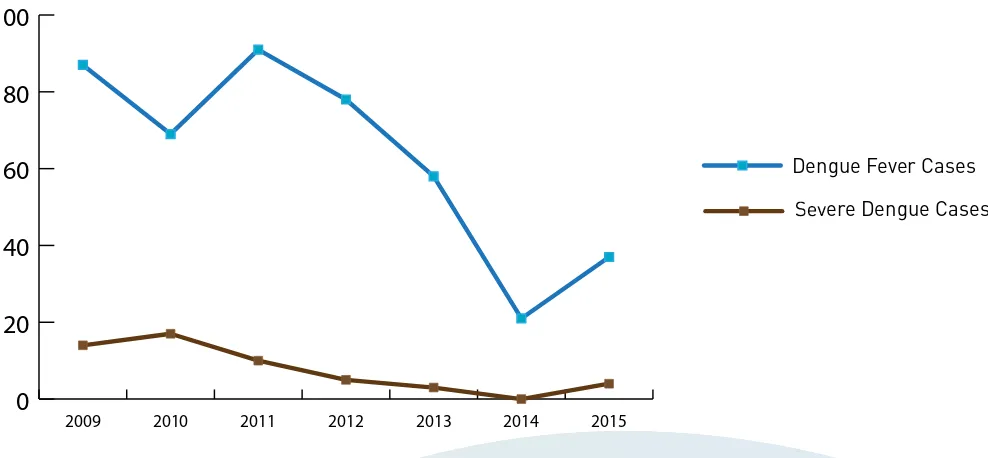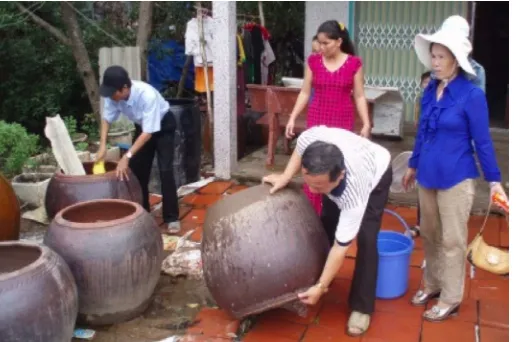India
Thailand
Can Tho
w w w . S - E -o r g
VIETNAM
Project Lev
The problem
Dengue fever is caused by a mosquito-borne virus and is common throughout the tropics. It is seldom fatal but causes debilitating fever and intense discomfort. Those infected require a long period of recovery and, in extreme cases, the disease can lead to complications such as organ damage or internal haemorrhaging. It is especially dangerous for children.
Disease transmission is linked to mosquito activity, which increases as the temperature rises and as there is more access to clean water for breeding. Climate change can lead to increased populations of the Aedes aegyptii mosquito that carries dengue and an expansion of the species’ range. This project studied the empirical connection between dengue fever incidence and climate parameters in Can Tho city. It also tested responses designed to increase the capacity of public health staff and city residents to reduce exposure to dengue including creating new institutions for health promotion.
Finding Solutions
Through research, the project identified that in Can Tho the number of diagnosed cases of dengue fever is linked to humidity levels. With increasing average temperature, and increasing rainfall outside the rainy season, dengue fever is becoming more common throughout the year although the incidence remains higher in the rainy season from July - December.
The research shows that preventive measures have not been based on risk assessments, that there was limited information on preventive measures and that there was no assessment of community behavioural change as a result of awareness raising measures.
Historical practices for dengue prevention focused on annual awareness campaigns directed at the general public and health clinic staff immediately prior to the rainy season, and mosquito control measures in response to outbreaks of diagnosed dengue cases in the areas where they are recorded. The research showed that prevention measures should be
N SUE F O R S O CA L A N D E N VR O N M E NAR A N SO N -NE R N AO N A L
C L
M A
E R E S
L
E N C E C A S E S
U D Y
C
ho, Vietn
CLIMATE CHANGE COMPLICATES DENGUE FEVER PREVENTION IN VIETNAM
2012–2016 | Implementing Partner: Cho Cimte Chnge Coordintion Ofice (CCCO Cho)
HE CON
EX
For more informtiobout our projecnd pubictions, pese visit: i-s-e-t.org /projec ts/c-tho-resiience-fever.htm
Pubished Apri016
© Huy NguyenSE, 2015
Cho irowing city o bout one miion peope,
pproximtey hf of whoive in the city’s peripher
ruristricts. Rpind conversiond popution
increse in peri-urbres just outside the
high-density urbn core mens tht new residentre
moving intres tht stivot of open spce
nimited pubic heth infrstructure. Dengue fever
incidence hs incresed in Cho in recent yers.
Recent migrnts whive in poor quity housing
SET-International | Climate Resilience Case Study
undertaken year-round and that effective prevention required mosquito control measures before dengue outbreaks occurred.
The project team developed new procedures for community-based monitoring of mosquito larvae in four target wards of the city: two in the densely developed urban core and two in peri-urban areas facing rapid conversion of land from agriculture to urban use. Indoor and outdoor household containers were checked for Aedes aegypti larvae and pupae collection. A total of 20,531 containers were checked and a total of 1,951 pupae were collected during a year. Multivariate analysis of risk factors demonstrated that cleaning water containers, solid waste management and collection contributed significantly to reduced larval counts.
Monitoring showed that the peri-urban wards had more mosquitos and larvae than the more densely developed urban core. Results showed that residents of the peri-urban areas are at greater risk of becoming infected by dengue virus and demonstrated that multiple factors such as flooding, sanitation, water supply and household behaviour could be used to assess risk of dengue. Results from larvae monitoring are used to trigger mosquito control measures, such as spot spraying of insecticides, if threshold levels of larvae are reported.
In addition to the new monitoring mechanisms, the project introduced broader surveillance for dengue fever cases by training health professionals of public and private clinics and members of community groups in identifying dengue symptoms and reporting. Teachers were trained and dengue FIGURE 1
CASE INCIDENCE OF DENGUE HOSPITALIZATIONS PER 1,000,000 PEOPLE BY MONTH IN CAN THO CITY FROM 2001 – 2011
fever prevention was introduced into science and health curricula and school activities in 11 primary schools in the four target wards of the city. In addition, the schools developed fish breeding programs and sent guppies home with some of the children to put them in reservoirs or ponds in order to control the mosquito population. Broad testing of the student population revealed that over 90% had good or excellent knowledge of dengue fever prevention and control measures by the end of the program, and teachers reported they intended to continue to teach this material.
Ward level leaders also organized Ward Health Clubs with project support in four different wards of the city. These are community-based membership organizations designed to attract interest from people of all ages, and drawing on existing community organizations. Their activities included popular education and public health training, community promotion of public health and community monitoring of dengue fever cases and prevention measures. Each of the Health Clubs attracted dozens of members, and they were active throughout the project in promoting household behavioural change to help prevent dengue fever. The Preventive Health Centre prepared educational materials using a variety of media including print materials for households to keep on the wall of their home as reminders of dengue risk and prevention measures and other media such as radio and television promotions.
Climate change complicates Dengue Fever prevention in Can Tho | Vietnam 2016
Outcomes
Improved surveillance and awareness methods led to a change in behaviour by community residents. Prior to the project, only 20% of people who had a fever would go to the community clinic for diagnosis but, with greater awareness of dengue risks, this proportion increased to over 60% by the end of the project. The number of households cleaning their own property to reduce mosquito habitat increased from 32% to over 90%, while more than 50% of households were also taking action to remove trash from public areas as well.
Monitoring of mosquito and larval populations across the city demonstrated that they were lower in the four pilot wards after interventions started in early 2014, suggesting measures were effective in reducing mosquito populations. The number of dengue fever cases in both 2014 and 2015 in the target wards was much smaller than in the 5 previous years, despite FIGURE 2
DENGUE FEVER CASES IN 4 PILOT WARDS IN CAN THO
population growth (see Figure 2). There are other factors, such as rainfall and dengue outbreaks, that complicate any analysis, but the initial results are promising.
The city’s public health staff and clinics are now more aware of the importance of dengue monitoring and
prevention in these high-risk areas, and awareness materials have been developed for replication by health clubs and school programs. However, these require modest ongoing support from both the Department of Health as well as the Department of Education.
Lessons from the project, including community awareness raising and engagement mechanisms, were shared with an additional 11 wards throughout the city through training and capacity building sessions with community health workers.
INFRASTRUCTURE ECOSYSTEMS CAPACITY INSTITUTIONS
Reduce habitat for mosquito larvae by clean-up and prevention of standing water
• Improve awareness through school
programs
• Train health oficials in dengue fever
awareness and prevention measures
Ward level health clubs created to support dengue prevention and healthy lifestyles
Introduce predators (ish) for mosquito larvae
Public awareness promoted through communication tools aimed at vulnerable households
Monitoring programs implemented throughout the year instead of seasonally.
Summar y of Resilience Measures by t ype
0
20
40
60
80
100
S!vere Dengue Cases
Dengue Fever Cases
2015 2014
2013 2012
2011 2010
C l i m a t e R e s i l i e n c e C a s e S t u d y : C a n T h o , V i e t n a m
C C C O C a n T h o
D i r e c t o r :
K y Q u a n g V i n h k q v i n h @ c t u . e d u . v n
A d d r e s s :
8 0 P h a n D i n h P h u n g , C a n T h o
T e l : 0 7 1 0 3 8 1 9 2 2 3
F a x : 0 7 1 0 3 8 1 9 2 2 3
W e b s t i e :
b i e n d o i k h i h a u . c a n t h o . g o v . v n
C o n t a c t I n f o r m a t i o n
I S E T i n V i e t n a m
C o u n t r y C o o r d i n a t o r :
N g o L e M a i l e m a i @ i - s - e - t . o r g
A d d r e s s :
1 8 1 / 4 2 , 1 A u C o , Ta y H o , H a n o i
T e l : 0 4 . 3 7 1 . 8 6 7. 0 2
F a x : 0 4 . 3 7 1 . 8 6 7. 2 1
W e b s i t e: i - s - e - t . o r g
LESSONS FOR POLICY AND PRACTICE
The project results show the importance of community-based monitoring, and awareness and prevention practices for dengue fever as climate change leads to greater mosquito activity in the Mekong Delta. Surveillance methods should include multiple indicators of dengue risk in order to focus preventive measures in areas where risks are higher. Larval monitoring is critical to enable timely and targeted mosquito control. These methods require the engagement of community actors and other city agencies (e.g. Department of Education, ward officials) in addition to
Department of Health staff. Health clubs can serve an important role in community development and promoting health outcomes, including dengue fever prevention.
Local partners
• Can Tho Department of Health, Preventive Health
Centre;
• Can Tho University of Medicine and Pharmacy; and
• Can Tho Medical College
FIGURE 3
LOCAL HEALTH STAFF WORK WITH COMMUNITY TEAMS TO CLEAN POTS
Impl"#" $%"&'(% )"*$ +titut",or Social and Environmental Transition-International
and the Climate Change Coordination Ofice of Can Tho City (CCCO Can Tho) Funded by the Rockefeller Foundation
under The Asian Cities Climate Change Resilience Network (ACCCRN)


